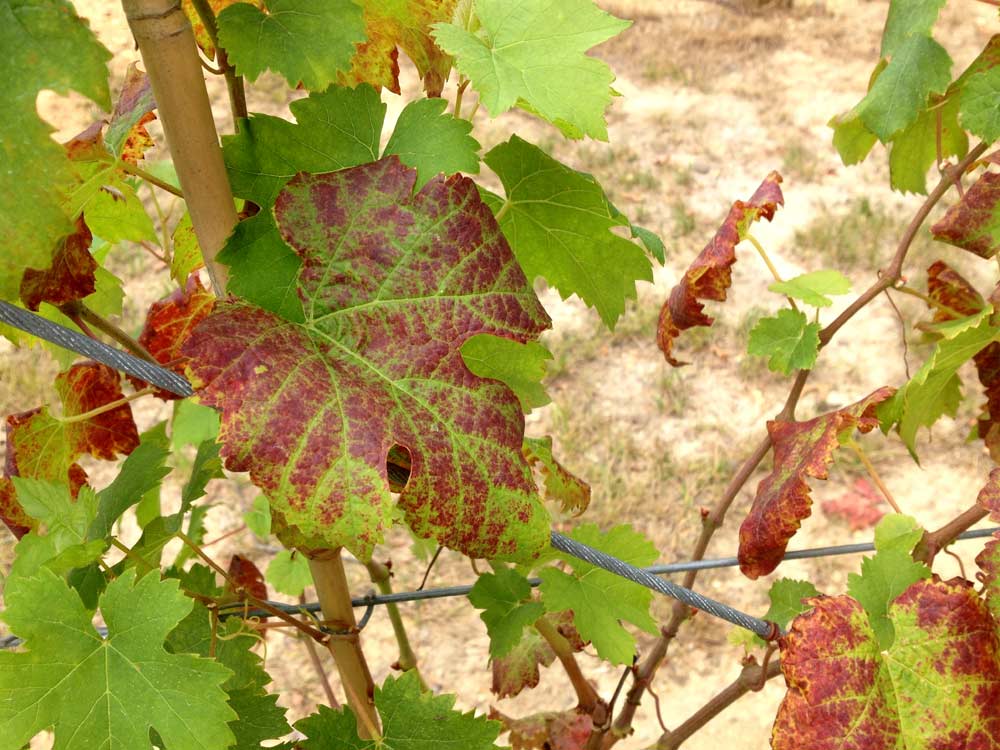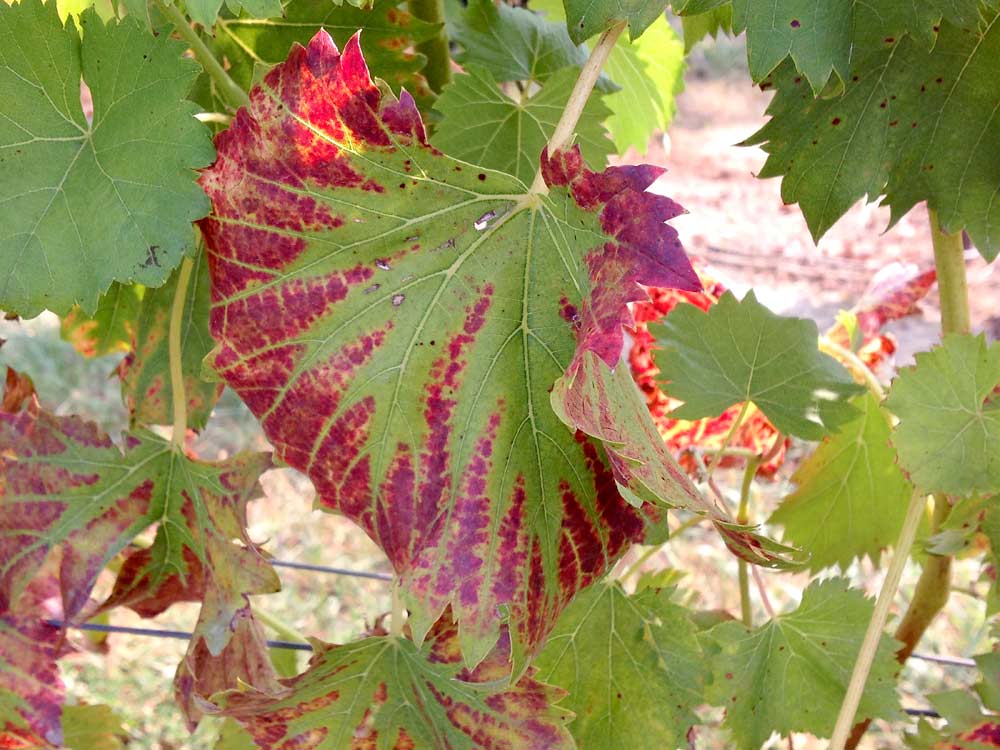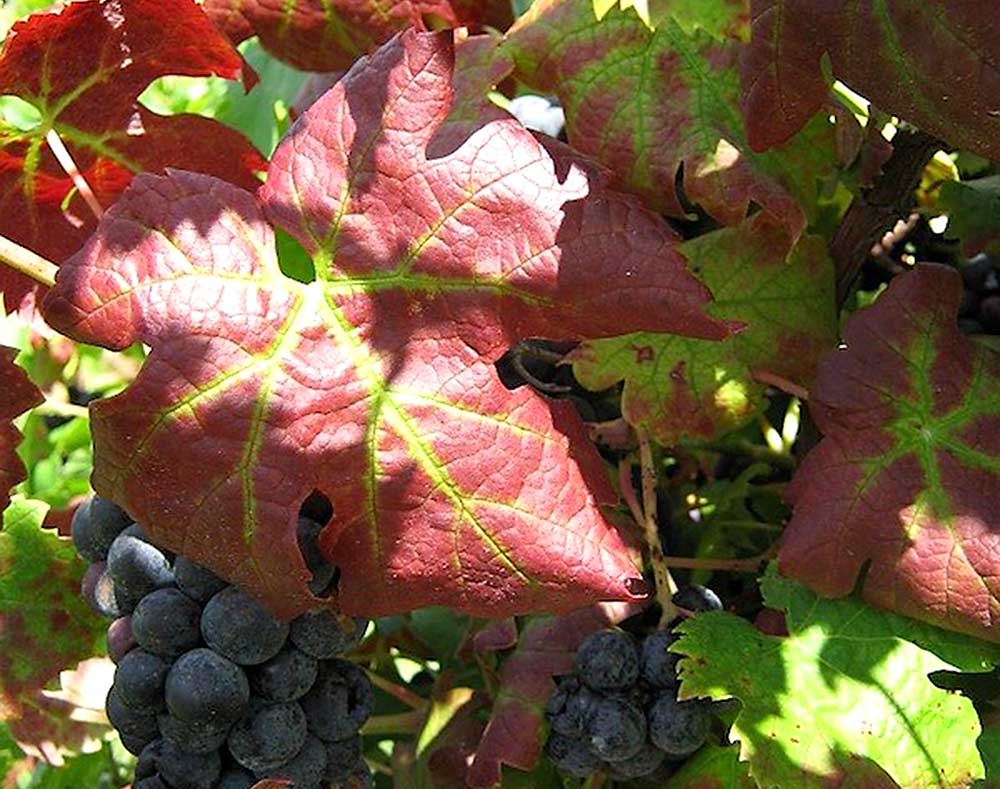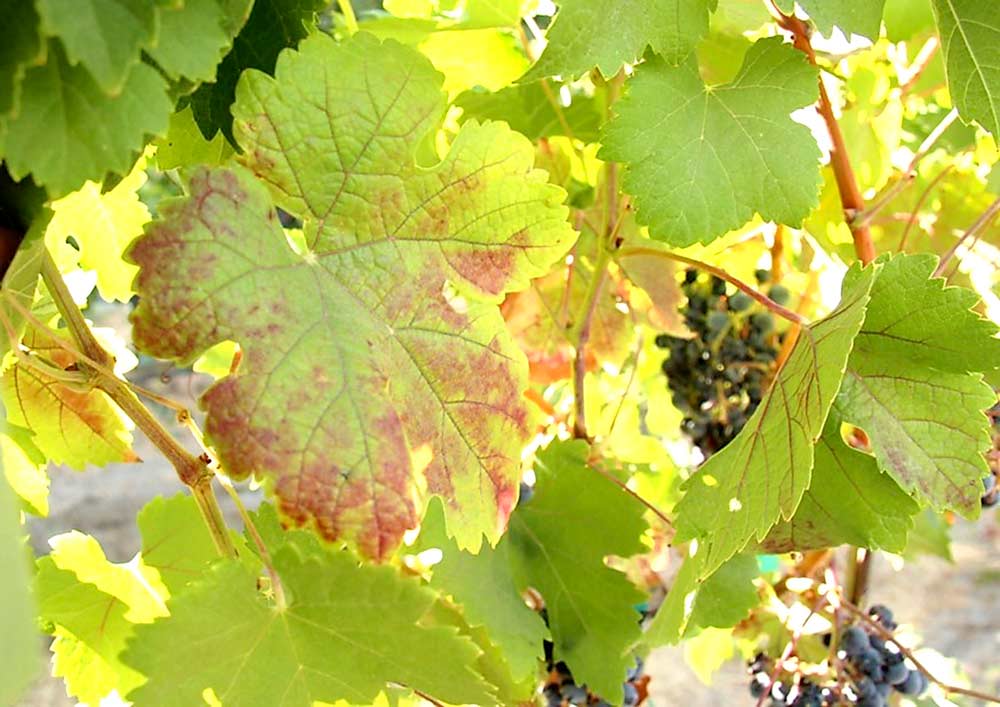
K deficiency (Photo courtesy of Hemantkumar Gohil)
– by Hemant Gohil, Gary C. Pavlis, Daniel Ward and Mizuho Nita
Red leaves in the vineyard can be caused by many different stresses, both biotic (viruses, bacteria, and fungus) and abiotic (nutrient deficiencies, cold injury, damage to root systems).
Anything that can cause blockage or stress in the vascular system where water and nutrients are transported can result in the development of red leaves.
Though the timing, pattern of appearance and spread could be different, the overlapping of the symptoms, especially the reddening of leaves, makes it very difficult to identify the cause based only on visual symptoms.
The best strategy, therefore, is not to rely on guesswork, but to get the vines tested for accurate diagnosis as soon as possible.
Following are examples of abiotic and biotic stresses that are often associated with red leaves on grapevines.
Nutrient deficiencies
Potassium (K) deficiency develops when vines receive less potassium than is required for normal growth and development, or when low soil pH levels (for example, less than 5 for Vitis vinifera) decrease the availability of potassium to the roots.
Potassium is a mobile nutrient and, in the case of deficiency, the plant prioritizes potassium to upper, younger leaves. That means reddening occurs in the older, lower part of the canopy first.
Symptoms typically appear in early to late summer. In red grape varieties, leaves turn red between veins starting from the edges, and as deficiency gets severe, they turn purple. In white grape varieties, deficient leaves turn chlorotic (pale yellow or white), due to insufficient chlorophyll.
To monitor plant K status, growers should perform petiole analysis every two to three years, ideally during bloom.
The target K level in petioles should be between 1.5 percent and 2.5 percent if sampled during bloom, and 1.2 and 2 percent if sampled 70 days after bloom. Apply potash fertilizer, either foliar or to the soil, depending on the urgency.
When there is chronic potassium deficiency, laboratory soil testing for nutrient and pH levels should be conducted.
Magnesium (Mg) deficient leaves may resemble K deficient leaves; however, the discoloration starts from the end, creating a wedge shaped pattern.

Mg deficiency (Photo courtesy of Hemantkumar Gohil)
As the deficiency becomes severe in red varieties, interveinal chlorosis could become red to brown. In white varieties, the chlorosis remains yellowish.
Target Mg level in petioles should be 0.3 to 0.5 percent at bloom; or 0.35 to 0.75 percent if sampled 70 days after bloom.
To correct Mg deficiency, magnesium salt, also known as Epsom salts, can be used if soil pH does not require adjustments. If the soil is acidic, apply dolomitic limestone (Mg-containing limestone) as it will also raise the pH, improving the rate of Mg uptake.
Phosphorous (P) deficient leaves show interveinal reddening, while white varieties show chlorosis. Unlike other major nutrients, phosphorous offers greater flexibility in terms of timing of application as it is less mobile in soil and does not leach away easily.
The target P level for leaf petiole should be between 0.13 and 0.30 percent, depending on the type of rootstock.
Mono-ammonium phosphate (MAP) and di-ammonium phosphate (DAP) are common sources of phosphorous fertilizer. Adjust the soil pH if it is lower than optimum to improve phosphorous uptake.
Diseases
Viruses of grapes such as leaf roll and red blotch can also cause red leaves and result in reduced vine vigor, poor fruit set, reduced fruit quality and early decline of vines.
Since there is no cure available for viruses once vines are infected, the only way to cure the infected vineyard is to rogue out infected vines and replant with virus-tested planting materials from dependable nurseries.
Grapevine leafroll disease symptoms typically appear around the onset of fruit ripening and spread as the season progresses.

Grapevine leafroll disease (Photo courtesy of Hemantkumar Gohil)
In red varieties, red to purplish discoloration is observed on interveinal areas of the leaf, but the veins stay green.
In white varieties, the interveinal area will become pale green while the veins turn yellowish. In addition, downward cupping or curling from the edges is typical of leafroll symptoms. The discoloration of leaves will often develop randomly within the vine canopy.
An upward or downward movement of the discoloration will not occur as it does with some of the nutrient deficiencies.
There are several viruses that can cause grapevine leafroll disease. Grapevine leafroll-associated virus-1 and -3 (GLRaV-1 and -3) can be disseminated by mealybugs or scale insects. Scouting for these vector insects can be done during the season (around bloom) by carefully examining the basal area of shoots and underneath the bark.
Mealybugs can be managed through insecticide treatments, however recent research showed that even a small population of mealybugs can quickly spread grapevine leafroll disease.
Grapevine red blotch disease creates blotches of red pigment randomly on leaves of infected vines and can be detected at any stage of vine growth in any part of a vine.

Red blotch (Photo courtesy of Hemantkumar Gohil)
However, it can easily be mistaken for potassium deficiency or leaf roll virus, especially when leaves cup or roll.
Because of the recent recognition of the virus, there are ongoing efforts to understand how (or if) it spreads in vineyards. It is known that the red blotch virus can be disseminated through propagation and grafting with infected materials.
For the two viruses mentioned above and any other viruses, the vines will always be infected. Thus, it is recommended to obtain virus-tested materials from reputable nurseries, with virus-testing procedures in place, when establishing a vineyard.
If you have propagated your planting materials from existing vineyards or obtained materials from noncertified nurseries, consider sending a representative number of cuttings for virus testing before planting.
Typically, seven to eight young, matured leaves per vine, and 30 to 50 leaves per sample are sufficient, but communicate with the virus testing lab for their specific sampling protocol.
Crown gall is caused by a bacterium (R. vitis) and can be common in cool climates. Severe winters or temperature fluctuations in the early spring damage bark and vascular tissues and allow R. vitis to move into the vine cells and cause infection.

Crown gall (Photo courtesy of Hemantkumar Gohil)
Typical symptoms are formation of galls on the trunk; however, these galls can be very small and may form under the bark.
For that reason, crown gall could be mistakenly identified as a nutrient deficiency, as red leaves resulting from the stressed vascular system are readily visible. Other wounding events, such as physical damage to the trunk by hitting it with equipment such as line trimmers, can also encourage the infection by R. vitis.
As with virus diseases, crown gall-infected vines are infected for life, because crown gall bacterium is a systemic pathogen.
Thus, management of crown gall is very difficult. Obtain clean plant materials and make sure to select varieties that suit your site.
Cold-tender varieties, such as Merlot and Tanat, tend to have higher risk of crown gall than many others.
Moreover, stressed vines tend to be more sensitive to cold, so proper viticultural practices such as site selection, crop load and foliar disease management can lower the risk of crown gall.
Having multiple trunks from above the graft union and hilling up to cover the graft unions during the winter months are other preventative strategies.
Assessment of suspicious vines
It can be very difficult to accurately identify the cause of red leaves. Virus testing is expensive, so the first recommendation is to inspect trunks for integrity and then perform petiole analysis.
If trunk diseases and nutrient deficiencies are ruled out, samples should be sent for virus testing. •
READ MORE (PDF) : Red Leaves In The Vineyard
– by Hemant Gohil, Gary C. Pavlis, Daniel Ward and Mizuho Nita
Gohil and Pavlis are agricultural agents for Gloucester and Atlantic counties, respectively, in New Jersey. Ward is an Extension specialist in pomology for Rutgers University. Nita is an assistant professor and Extension grape pathologist for Virginia Polytechnic Institute and State University.






My father’s vineyard starts to happen like this and we always try to find a way to solve it. Luckily I found this. I’ll let him know. Thank you so much.